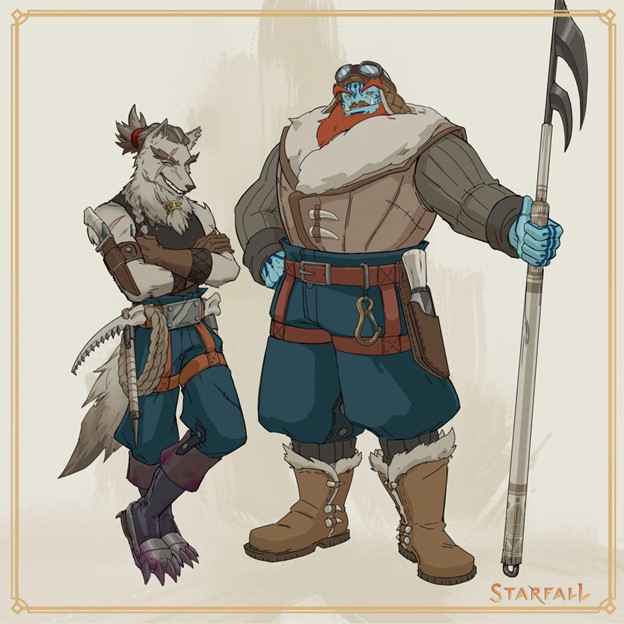Skywhalers

“There’s no Gods in the Deep Sky, if there were, we’d have caught one by now.” – Old Skywhaler saying.
Whaling has been a part of life on the oceans of Lyra since the first Norvund ships entered the icy oceans of the North. However, while the Norvund were the first to master the art of hunting the giants of the deep, the Blue Orcs who lived on the high peaks of the Screaming Mountains were the first people to successfully hunt Skywhales. While the occasional Skywhale would dive too low, and find themselves on the receiving end of an Ork spear, it wasn’t until airship travel was mastered that Skywhaling became a booming industry.
Skywhales are one of the largest animals on Lyra, yet their diet consists of some of the smallest species on the planet, namely Sprites & Lumipods (tiny creatures that feed on microscopic Lumite dust). Their high-lumite diet is believed to be the source of the Skywhales’ flying ability.
Early adventures hunted Skywhales for the simple fact that they could feed a small settlement for a week on a single carcass. It wasn’t long before the Skylanders realized that whale skeletons, while incredibly strong, are nearly weightless, and are therefore a perfect building material for airships. But the discovery that Skywhale blubber could be burned to produce Lumos gas made whale oil an instant commodity.
Because Whale Oil serves as a competitor to their Lumite monopoly, the Alliance has outlawed its sale. The ban failed to curtail its use, instead creating a thriving black market, creating a huge source of wealth for Skyland crime organizations such as the Syndicate and the 21.
While still plentiful in the skies of Lyra, the increase in hunting has caused the Skywhales to move their migration routes to the Outer Rim. In turn, this has resulted in whaling ships needing to journey to the far reaches of the deep sky, an unexplored world filled with terrifying creatures, such as Giant Cloud Kraken, and deadly flying conditions.
It is only when a ship has reached these unwelcoming regions that they may finally do battle with the great leviathans of the sky, armed with little more than harpoons and Spritesilk rope. With such conditions, each voyage a Skywhaling crew embarks on, holds the promise of being its last.
Such a dangerous form of employment can’t afford to be selective, and so anyone, from any species or background, can join a skywhaling crew. Because of this, a diversity of species and backgrounds can be found Skywhaling, though the Norvund and the Blue Orcs are the most highly represented, due to their inborn toughness and the emphasis of big game hunting in their cultures.
Over the centuries, Skywhaler culture has evolved in its own rite. Despite the illegality, whalers can be found in nearly all settlements. Skywhaler’s are known to wear the story of their lives on their body, from their many scars, to their abundance of tattoos, and the trophies of past hunts. Whalers are known to have admiration and respect for their fearsome rival in the Sky. No part of a kill goes to waste, and it goes against their code to kill calfs or pregnant whales. Those who violate this code will find themselves on the edge of a Whaler’s knife.
While some whalers have created family fortunes and corporate dynasties through their fearlessness, for most, the whaler’s life is a short one. This short longevity of the trade has led to a culture that preaches living for the moment, and whalers are known to drink and love like every night is their last.
Most of all though, the Skywhaler’s life is about the hunt, ships will often get recognized for their achievements. Famous captains even get recruited by towns to hunt Sky Monsters such as Kraken or Dragons. There’s an old saying which embodies whalers’ fearless pursuit of big game: “There’s no Gods in the Deep Sky, if there were, we’d have caught one by now.”



